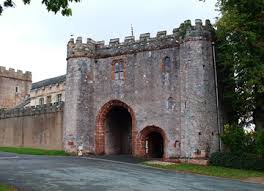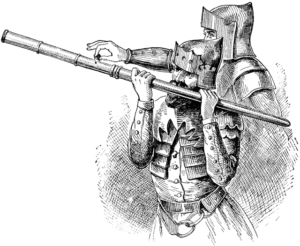Why was Torre Abbey’s Gatehouse built?
When the antiquary John Leland visited Torre Abbey in the sixteenth century he described “three fair gate houses‟. One of these was the Mohun gatehouse (pictured) while the main north gatehouse’ foundations, just outside the present-day gates at the end of King’s Drive, were uncovered during road-works in 1969; and the location of the third gatehouse is unknown.
Monastic gatehouses were for the regulation of incoming and outgoing traffic and as such they were usually highly ornamented and had large windows-the Mohun gatehouse is conspicuously bare.
Access to the inner part of the Abbey was provided by two double-chambered gate halls, one for vehicles and the other for pedestrians. Both were controlled by wicket-gates, the hinges and bolt-holes can still be seen. The gatehouse provided accommodation, both first and second floors being divided into at least two chambers with fireplaces, while the ground floor porter’s lodge had a fireplace and space for a bed.
What is unusual here is that Torre Abbey had a crenellated gatehouse meaning that it was a fortified coastal monastery – monastic gatehouses were not generally designed to serve a defensive function. The only other South West church to be granted a licence to crenellate was Buckland in 1337.
The Mohun gatehouse is the only surviving defensive part of the building, but originally there was a stone wall surrounding the Abbey – in a 1473 charter the canons were confirmed that land they held along the length of their wall on the western side of the Abbey belonged to them.
In medieval England a licence was required to ‘crenellate’, or to install a battlement which has gaps to allow for the launching of arrows or other projectiles. These gaps are termed ‘crenels’, the word sharing its origins with cranny, meaning ‘a small opening’.
The purpose of licensing crenellations isn’t that clear. Some historians believe that restricting the number of fortifications would prevent them being used against a royal army. Others believe that battlements were a status-symbol for the socially ambitious to show their noble rank.
And our Abbey’s gatehouse is clearly a functional structure – it doesn’t appear to have ever featured any sculpture or decoration on any façade and the three surviving round turrets have narrow window slits and hand-cannon loops.
Torre Abbey was fortified to withstand a full-scale attack, the main threat to monasteries being occasional raiding. Indeed, as it is so close to the house, the gatehouse may have been built as a defensible retreat during raids. As the gun-loops are mainly positioned to provide a field of view southward and westward, the gatehouse was therefore the defensive structure for the seaward side of the Abbey covering the shore and quay and the causeway from the main gate. The gatehouse builders expected an assault to come from the sea.
When the gatehouse was constructed isn’t known but it would have been after 1370, when cannons became to be used. On 22 and 23 June 1372 a Castilian fleet and an English convoy fought each other at the Battle of La Rochelle. The Castilian victory was total and the entire English convoy was captured. This defeat damaged English seaborne trade and supplies and threatened our Gascon possessions. It also led to an increase in raids on the South West and caused a series of defensive measures to be put into place. Though there is no record of the Abbey being attacked, its relationship with Dartmouth put the Abbey at risk of attack by opportunistic raiders. The gatehouse could then be a part of a network of coastal defences.
There is another possibility. In the 1380s there was a sudden burst of castle building across southern England. Our gatehouse builders may not have had the French in mind, but an enemy closer to home.
Ever since the Black Death in the middle of the fourteenth century English peasants had been troublesome. The plague had wiped out a third of the population and caused massive social upheavals. Labour was suddenly in short supply and peasants suddenly found themselves in a much stronger bargaining position. Land owners were finding it increasingly difficult to enforce traditional demands for unpaid services.
In 1381 the peasants of Essex, Kent and Sussex rose up and attacked manor houses and castles. Agricultural tools were destroyed and manorial accounts were burned. This was the Peasant’s Revolt.
This seems to have convinced the governing classes that society was falling apart and there was an urgent need to reassert the fundamental order of society, to stress authority and their right to rule. Was Torre Abbey’s fortified gatehouse part of that attempt to re-establish control over a revolting peasantry?
It would have been some time after the Abbey was disestablished in 1539 that the gatehouse and Abbey were finally stripped of their defences. On August 1, 1635 a letter was sent from aboard a ship called ‘The James’. It was sent, “by your honours most faithful servant Will Monson” and addressed to Sir Francis Windebancke, Secretary of State. It contained the following passage: “We departed from Plymouth the 26th of July. But in our way I desired my Lord to look into Torbay, being informed of many abuses there comytted to the prejudice of the King’s service (as namely), that an auncyent castle being there seated that commanded part of the Road is quite abolished, and the iron peeces made into horse shoes.”

You can join us on our social media pages, follow us on Facebook or Twitter and keep up to date with whats going on in South Devon.
Got a news story, blog or press release that you’d like to share or want to advertise with us? Contact us




































